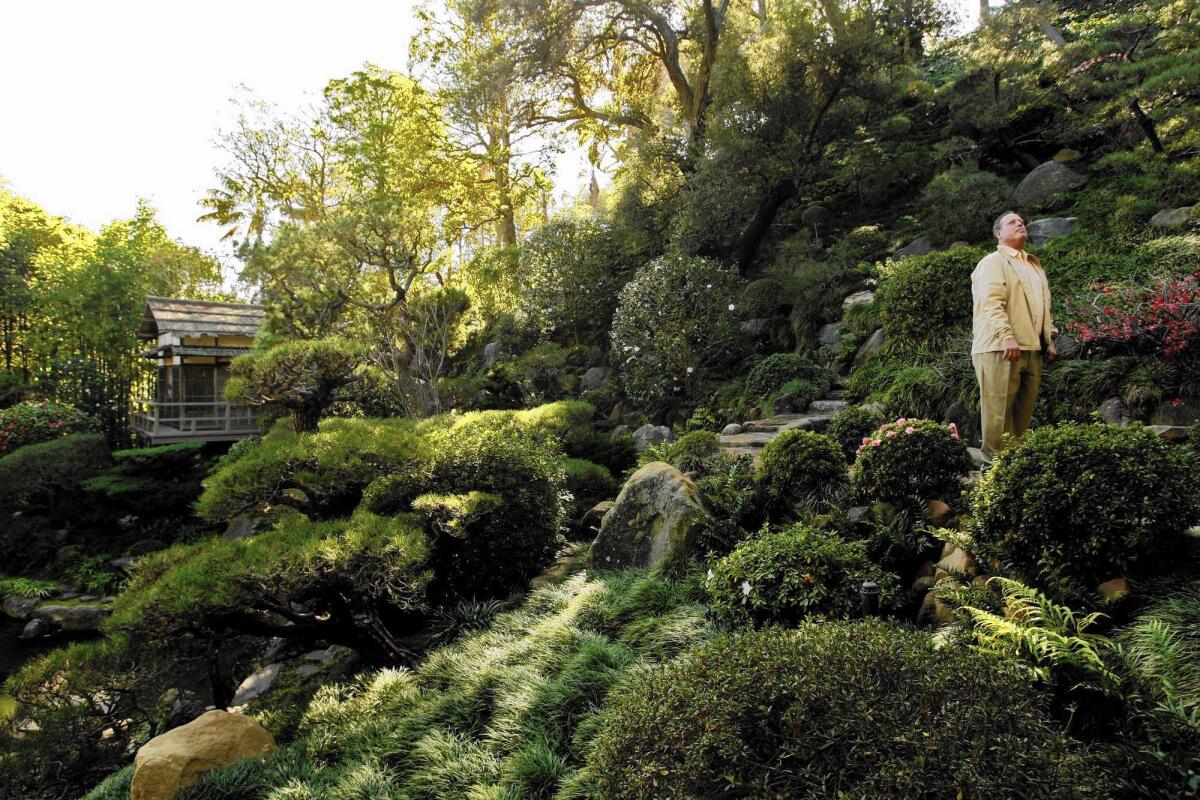UCLA, heirs wrangle over fate of a tranquil Japanese garden

- Share via
Half a century ago, the man who built the Broadway department store chain and his wife gave to UCLA their house and the Japanese garden that spilled down the hillside below it near the Hotel Bel-Air. The UC regents, UCLA’s governing body, promised to maintain the garden forever.
Sounds simple enough, but for three years the university and the donors’ heirs have wrangled over the fate of the garden, which experts consider to be one of the finest examples in North America of a landscaping style meant to inspire Zen-like tranquillity.
Decades ago, UCLA opened the garden to visitors on a limited basis, and thousands made the necessary reservations to stroll the steep pathways. In May 2011, the university closed the property to the public and months later announced plans to auction the two acres containing the benefactors’ Georgian Colonial house on Siena Way and the garden on Bellagio Road.
The heirs successfully sued to temporarily halt the sale and now seek to permanently prevent the regents from destroying the garden or selling it without conditions that would guarantee its preservation.
Despite four mediation sessions, the most recent in November, the two sides have failed to come to terms. But, with the case expected to go to trial this summer in Los Angeles County Superior Court in Santa Monica, some of those involved say the family members and the university could yet resolve their differences.
“A settlement is always on the table,” said Craig de Recat, an attorney for the Regents of the University of California, which owns UCLA and pays its bills.
Walter W. Moore, an attorney for the heirs, agrees that a settlement is possible. He added that the university runs the risk of alienating potential contributors by reneging on a written promise.
“Who’s going to keep contributing to higher education,” he said, “if you’re worried that when you’re six feet under the promise will be broken?”
Indeed, the situation is a reminder that universities must tread carefully, said Leslie Lenkowsky, a professor of philanthropy at Indiana University.
“There are limited circumstances under which universities can transfer gifts without discouraging future donations,” he said. “There is an integrity issue.”
The garden was donated by Edward W. Carter, a former UC regent, and his second wife, Hannah Locke Carter, under a 1964 agreement that the university would maintain it in perpetuity. In 1982, the parties agreed that proceeds from the sale of the Carters’ house would be used to fund certain endowments and professorships.
Carter died in 1996. Hannah Carter vacated the house in 2006 and died in 2009.
The next year, the UC regents asked the Superior Court in Alameda County, where the University of California is based, to allow the properties’ sale and to lift the “in perpetuity” requirement. They argued, and the court agreed, that “changed circumstances” — including the rising costs of maintaining the garden — made continued ownership and maintenance “impracticable.”
“The unavailability of parking and the location in a residential neighborhood, as well as significant safety and access issues for those with disabilities, make it impractical to operate the garden as a public amenity,” the university said.
De Recat, the UC attorney, said the university is spending about $200,000 annually to maintain the garden, atop a substantial amount it paid recently to repair the pagoda roof and irrigation system.
In putting the properties up for sale, the university set minimum bid prices of $9 million for the residence and $5.7 million for the garden.
The action offended Hannah Carter’s children. They sued. In 2012, a Los Angeles County Superior Court judge, who concluded that UCLA and UC officials had behaved in a “duplicitous” manner by failing to notify the heirs of their plan to unload the garden, ordered a temporary halt to the proposed sale.
According to the heirs’ amended complaint, filed in October, the regents’ petition to the Alameda County court was intended to make the court believe that “circumstances not known or anticipated” had made caring for the garden impracticable when, in fact, UCLA was well aware of the parking shortage and the fact that long-term maintenance would require millions of dollars.
The garden was commissioned in 1959 by oilman Gordon Guiberson and his wife, Verabelle. Architect Nagao Sakurai of Tokyo (known for designing the Japanese government’s Imperial Japanese Gardens at the Golden Gate International Exposition in San Francisco and the World’s Fair in New York in 1939) and garden designer Kazuo Nakamura of Kyoto created the setting, with some structures built in Japan and reassembled at the site. The garden was completed in 1961 but underwent a significant restoration in 1969 after heavy rains eroded the hillside.
Over the years, visitors have walked amid the garden’s bamboo, Japanese black pines and blooming magnolia and camellia trees, admiring streams, a waterfall, a koi pond, a teahouse and weathered stone sculptures dating back centuries.
One possible outcome that could satisfy the concerns of all would be to sell the garden to a buyer who would agree to maintain it, Lenkowsky said.
“I am optimistic that we will ultimately reach a settlement between now and the trial date in July,” said Jim Caldwell, one of Hannah Carter’s five children, who lives in Woodside in the Bay Area. “Alumni and donors want to believe in the university.”
[email protected]
Twitter: @MarthaGroves
More to Read
Sign up for Essential California
The most important California stories and recommendations in your inbox every morning.
You may occasionally receive promotional content from the Los Angeles Times.











